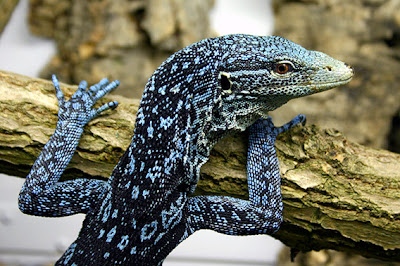Varanus macraei turquoise-blue monitor lizard
Conservationists discover more than 1,000 species in New Guinea
Treasure trove of
unknown varieties of animal, bird, fish, insect and plant have been
identified in the forests and wetlands of the Pacific island over a
period of just 10 years
Wattled Smoky Honeyeater (Melipotes carolae)
A new type of tree kangaroo, a 2.5-metre-long river shark, a frog with vampire-like fangs and a turquoise lizard are among hundreds of new creatures found and being documented in a report by conservationists working in the Pacific island of New Guinea.
Papua New Guinea tree kangaroo
Some 1,060 previously unknown species of mammals, fish and birds have been spotted in the volcanic island over a 10-year period.
The Final Frontier report, which was put together by WWF as part of its 50th anniversary celebrations, marks a brief respite from the escalating rate of animal and plant extinctions which is taking its toll across the planet and has left a quarter of all known mammals on the endangered list.
The species have all been discovered, at a rate of two each week, in the period from 1998 to 2008 by the various teams and researchers who have visited the region and its extensive forests, waters and wetlands.
Snub-fin dolphin
One team discovered a new bird, the wattled smoky honeyeater, within seconds of leaving their expedition helicopter.
Perhaps the most extraordinary freshwater discovery is the species of river shark which, given its size, has done well to evade discovery until now. The shy fish has been named the Glyphis garricki after the New Zealand zoologist Jack Garrick, who identified it. Because of its rarity it has immediately gone on to the endangered list.
River shark
In the salt waters a snub-fin dolphin that comes in a delicate shade of pink was spotted in 2005 and, after much scientific measuring and debating, now qualifies as the first new dolphin species to be found in more than three decades.
Dr Mark Wright, conservation science adviser at WWF, said the report was a fabulous reminder that "the world is full of fantastic and fantastical creatures, of quirky and improbable lifestyles. The more we look, the more we find".
Spilocuscus wilsoni cuscus (marsupial)
But he said that species diversity was rich the world over. "Perhaps it is so commonplace we ignore it, or maybe we've forgotten how to look. Let's take flies. Britain is home to more than 5,000 species of fly, and these are not everyone's favourite, but flies represent 5,000 entirely different responses to life's challenges.
"For instance, the holly leaf miner, whose nondescript larvae cause leaf blotching at this time of year – their entire world is limited to that tiny strip between the top and bottom of a single leaf. Those same life processes that we go through – feeding, growing, breathing – are still acted out, but now crammed into a creature far smaller than a grain of rice."
Orange snail
New Guinea is in an area known as the "coral triangle", a region with the most diverse marine eco-systems on Earth. In the 10-year period in question, 33 new fish species have been found in the waters around the island, including the damselfish, a strikingly brilliant blue wrasse and seven species of zig-zag rainbow fish, an 11cm-long creature which lives in shallow waters. In all, 218 new kinds of plants – including a flesh-like orchid, 43 reptiles and 12 mammals, 580 invertebrates, 134 amphibians, two birds and 71 fish have been found.
"It is precisely that endless variety of form and function that enthralls me, but this exuberance of nature is under threat," said Wright. "Despite the best efforts of groups like WWF, it is clear that we will not save all we would like to.
"Forest will continue to be felled, rivers dammed and coastlines developed. And species will be erased. Some extinction is inevitable – a consequence of Darwin's 'natural selection' – but humans are imposing intense pressures, leading to 'unnatural selection'. Nature is struggling to cope, but we have the ability and power in our hands to forge a future in which the environment is truly valued – we must choose to do so."
New Guinea is the second largest island on Earth, after Greenland, and is divided between the countries of Papua New Guinea and Indonesia. It holds the third largest tract of rainforest in the world and is home to around 8% of the world's species.
But while its relatively low level of human population had protected its species, illegal logging is now projected to strip the island of half of its forest cover by 2020.
Delias duria butterfly
To support WWF's anniversary report, writer and film-maker Stephen Poliakoff has made a short film which will include footage of some of the new species from New Guinea. Called Astonish Me, the film will be shown exclusively online by the Observer later this summer before being shown in Odeon cinemas as a short feature prelude to major films.
Poliakoff said that his drama – which stars Bill Nighy – had been inspired by the new discoveries made in the natural world.
Litoria sauroni tree frog
"What astonishes me is there are so many animals out there we are seeing for the first time from the very colossal squid to the largest insect in the world discovered recently – it's extraordinary in the 21st century that this is still going on. We think we know everything, but we don't," he said.












No comments:
Post a Comment